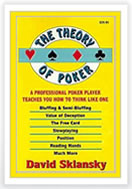 |
Author: David Sklunsky |
Book Review Part 2
| The book’s framework in place, Sklansky then begins applying it to the game’s strategems. Following some basic instruction regarding expected values for a given bet, computing hourly expectations, and understanding a given game’s betting structures, Sklansky then moves on to the topics of pot odds – including effective odds, implied odds, and reverse implied odds. It goes almost without stating that success at poker requires being able to calculate basic odds at any given point in the hand, based on the amount of chips already in the pot, the stack sizes of you and your opponents, and the cards and hands that are likely to be in play. In its simplest form, pot-odds discussions don’t even take into consideration the chances that bluffing strategies introduce into the game, since in complex mid-hand situations the possibility of a bluff also must be accounted for. But in many game situations, pot odds – meaning the odds the pot is giving you to call a single bet – are easy to calculate. From this basis more complex usages of pot-odds calculations can be constructed.With the basics of pot odds thus established, The Theory of Poker then moves on to a chapter called “Deception”, the jumping-off point into several more chapters on strategic player. Since playing purely by the odds would quickly make one an overly predictable player, success at poker must therefore include some element of “false” play, including bluffing and other misleading bets. Sklansky takes on several of these topics in turn, devoting a brief chapter to each of the following: winning big pots right away; free cards; semi-bluffs; defending against semi-bluffs; raising, check-raising; slow-playing; loose versus tight player; table position; bluffing; game theory; and inducing and stopping others’ bluffs. The book’s final chapters branch out into a handful of specialized topics, including: heads-up tactics; reading opponents’ hands; poker psychology; table and hand analysis; and finally, a brief appendix and glossary.One of the most important topics in Theory is Sklansky’s extended lecture on bluffing. Sklansky notes the truism that most inexperienced players bluff too frequently, particularly in loose, passive, low-stakes games where bluffing tactics are less likely to succeed. Sklansky risks running off the non-math-apt at times, though no one can seriously argue that one can be a good player without knowing a bit of math. Nowhere, though, does Sklansky’s love of numbers come more to the fore then when he discusses the relationship between game theory and optimum bluffing strategies. It’s hard at times to apply such abstract, academic knowledge to a situation at the poker table, but Sklansky indeed offers a solid proof that a little bluffing is a good thing. But be cautious, as with all poker strategies; good or bad, your mileage will vary.
The Theory of Poker has been a top-flight mathematics-based poker primer for decades, and for that reason it remains an essential poker book. While a handful of its more advanced strategies have been surpassed or better explained by later authors, it’s still a solid read. Becoming a better poker player takes both practice and the willingness to learn more about the game, and The Theory of Poker holds down a spot on poker bookshelves for a good reason: By learning the lessons taught in its largish-print 300 pages, you’ll gain an edge on the majority of the casual players you’re likely to play, both live and online. |